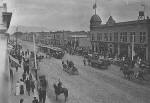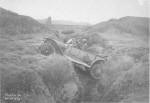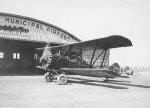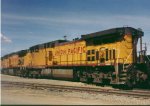
 |
TRANSPORTATION |
 |
1880s The Denver and Rio Grande Railroad reached town in November, 1882 and it was a major boost to the success of Grand Junction. Trains were of paramount importance in the era before automobiles, trucks and airplanes. Grand Junction became a major division point of the railroad, with repair and maintenance shops. |
|
|
 |
1890s William and Susan Carpenter bought two large coal mines at the base of the Bookcliffs, north of Grand Junction. To bring the coal to market, they also built the Little Book Cliff Railway which was finished in 1891. The railroad also transported building stone from an adjacent quarry, and bottled water from a spring. |
|
|
 |
1900s An electrically powered streetcar system was inaugurated May 27, l909 by the Grand Junction and Grand River Valley Railway. When few people owned automobiles, streetcars were a great convenience for many riders. Streetcars were smooth, quiet, non-polluting transportation. Earlier, the city had horse drawn streetcars 1890-1903. |
|
|
 |
1910s
Especially in
the west, roads between cities were primitive. Nonetheless, in October 1912
a hardy band of 27 motorists drove nine cars from Grand Junction to Salt
Lake City. The road often dwindled to a wagon track, streams were forded,
and deep mud was a problem. They made the journey in 11 days, and Salt Lake
greeted the pioneers with a banquet. The drivers shipped their cars home by
railroad. |
|
|
|
|
 |
1930s The Grand Junction Municipal Airport was on 700 acres where the larger current airport is located. It was dedicated June 14-15, l930. The first runways were unpaved. There was one hanger with a windsock, and planes including an Eagle Rock Biplane (pictured). In 1942 the airport was named Walker Field for the newspaper publisher who was a strong backer. During World War II, hundreds of Army and Navy cadets received basic flight training at Walker Field. (Dean Photo, Walker Field Airport Authority) |
|
|
|
|
|
|
 |
1960s The national Interstate Highway system was initiated in the 1950s. Interstate 70 reached Grand Junction in the 1960s. The highway through Glenwood Canyon was the final link in the national system and was not finished until the 1990s. (The Daily Sentinel) |
|
|
 |
1970s Hot air balloons carried a few animals and people aloft in the late 1700s. They evolved into massive, passenger carrying Zeppelins which crossed oceans in the 1900s, but faster airplanes prevailed over them. Colorful hot air balloons have made a comeback, with balloon and passengers propelled by breezes. The first balloon rally here was November 25, 1978. (David Canaday Photo, all rights reserved) |
|
|
 |
1980s A new Walker Field air terminal and parking areas were opened December 15, l982. The terminal is in contemporary architecture, with solar heating features. Auxiliary businesses at the airport also have expanded with extensive airplane sales, maintenance, rebuilding, air charter, flight training and car rental. These enterprises employ hundreds. (Debbie Hartlerode Photo) |
|
|
 |
1990s The Denver & Rio Grande Western Railroad was a mainstay for our passenger and freight traffic, from 1882. Its long corporate life as a regional carrier was altered, as railroads nationwide were incorporated into conglomerates. The D.& R.G., and the Southern Pacific, were merged into the Union Pacific. Burlington Northern Santa Fe also has service through here. (David Sundal Photo) |
|
|
 |
2000 & Beyond Public transportation had lapsed in Grand Junction. A new bus system, which also reaches to nearby communities, was inaugurated in February, 2000. The routes are designed to provide access to shopping, medical care, recreation and to intercity transportation. Suburban areas also are serviced in this comprehensive system, with plans for future expansion. (Debbie Hartlerode Photo) |
|
|
|
|
If you have
arrived at this page from a search engine |
|